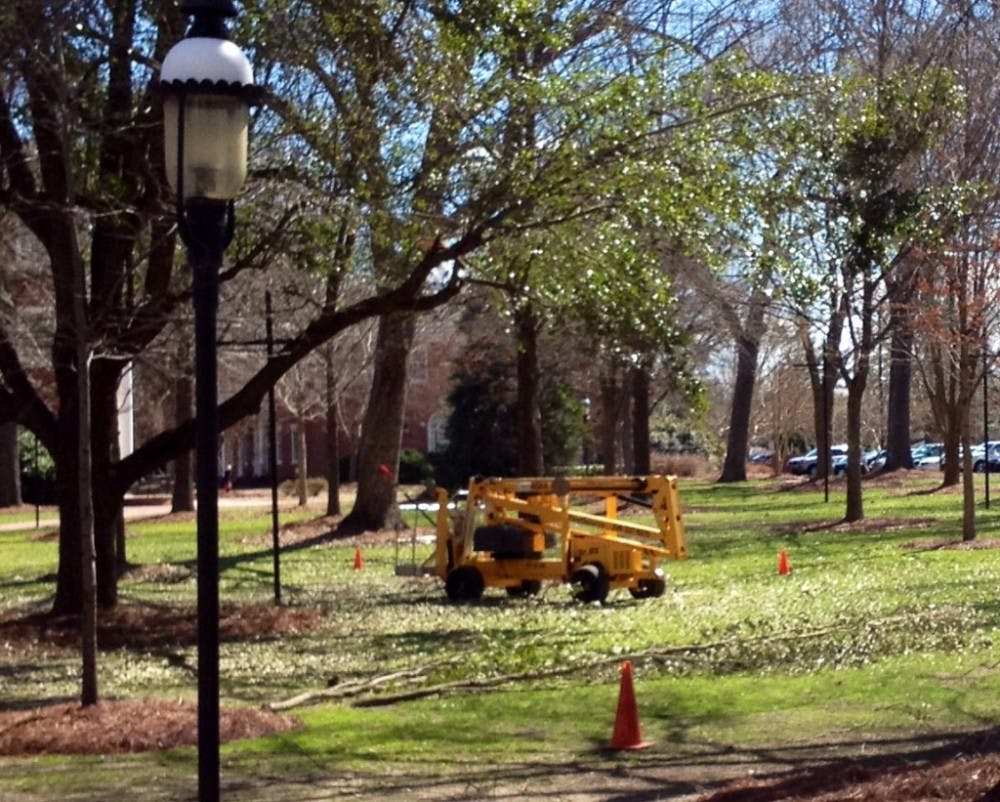As the remnants of snow and ice from the last two storms disappear from campus, Physical Plant continues its work to clean up debris.
While Physical Plant workers cleared sidewalks and brick walkways, Tarheel Tree Services helped remove the 100-year-old oak tree that toppled onto Henry Belk Pavilion.
Even though the storm is over, Elon University has long-term consequences to face.
Clearing the brick pathways and trees
On March 12, all major debris had been removed from trees and from student walkways according to Robert Buchholz, director of Physical Plant.Buchholz said the focus last week had been on the sidewalks and paths between the buildings, but there is more work to be done.
"Trees that have white, broken limbs need to be removed. When broken limbs are left, the tree becomes susceptible to disease," Buchholz said.
Even though most pathways have been cleared, students need to be cautious with broken limbs.
"Where there are trucks, students need to give a good distance from where they’re working," Buchholz said.
To prevent students from getting too close, the university placed caution tape around potentially dangerous areas, but some students have ignored the warning.
"There have been reports of students tearing down the caution tape by Williamson Avenue and the south side of Alamance Building," Buchholz said.
According to him, Campus Security has watched these and other spots after hours to prevent students from tearing down and taking the tape.
Belk Pavilion
Belk Pavilion was the only building that suffered significant damage. Buchholz said the repair process will take several weeks once reconstruction begins.Buchholz estimated the cost of reconstruction will be in the tens of thousands of dollars, especially because of the damage done to Belk Pavilion.
Dan Anderson, vice president of University Communications, said Elon is filing an insurance claim. No cost has been announced yet.
But Buchholz said they are getting close to deciding who will complete the repairs on Belk Pavilion. He hopes the decision will be made early this week.
Repairs will start with the classroom on the second floor. A classroom was not penetrated by the tree, but there was some water damage. A ceiling on the first floor also needs to be repaired.
Buchholz said that the university is lucky. A steel beam caught the tree, preventing it from causing more damage.
"It would have ended up in the classroom and done a lot more damage," Buchholz said.
‘Pending the green light’
Professors in first floor Belk could not move back into their offices until the Alamance Building Inspector approved it.According to Assistant Provost Peter Felten, professors were permitted to move back into their offices on March 14.
Other than professors moving back in, access to Belk Pavillion will be limited. Professors will not be allowed to have visitors.
“No students will be allowed in the building, and no one will be permitted on the second floor,” Felten said.
Professors will also have to abide by the construction company’s instructions when repairs begin.
“There will be times when they have to be out of the building,” Buchholz said.
Success despite challenges
More than 500 prospective students ventured to Elon for Fellows Weekend when the ice storm hit. Admissions and Fellows Programs worked to revise the schedule.The Leadership Fellows itinerary looked different from others during Fellows Weekend. Leadership Fellows needs two days to get to know the applicants and determine whether they would fit into the program. Interviews are a crucial part of that process.
“They are vital for us to make a decision,” said Steve Mencarini, director of the Leadership Fellows program. “It’s important that we learn more about students’ leadership experiences.”
He and other staff members from the Center for Leadership managed to reserve rooms in the Student Professional Development Center, upstairs Moseley and the Center for Leadership for the interviews—all done the night before.
On March 15, faculty, staff and students conducted 87 interviews in two hours, according to Mencarini. To accomplish this task, he said, faculty and staff conducted four interviews each. Students had between one and four interviews each.
Despite the weather and time constraints, Mencarini believes they succeeded in achieving their goals of meeting, interacting and interviewing prospective Leadership Fellows.


